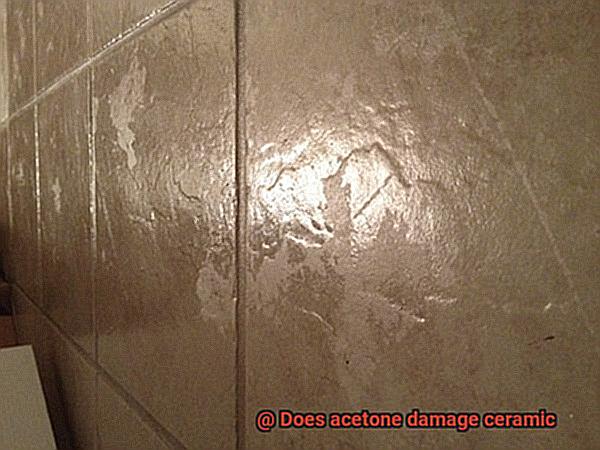If you’re anything like me, you can’t resist the allure of beautifully crafted ceramics. Whether it’s a stunning vase or a trusty coffee mug, these delicate yet resilient creations add a touch of elegance to our lives.
But here’s the burning question: does acetone, that handy chemical found in nail polish removers and paint thinners, pose a threat to our beloved ceramics? Well, get ready to uncover the truth as we take a deep dive into the world of ceramics.
Let’s explore whether acetone is a friend or foe to these precious pieces.
What is Acetone?
Contents
Ceramic, a resilient and versatile material, finds its way into our homes and lives in various forms. But what happens when acetone, a powerful solvent, meets ceramic? In this article, we will dive into the fascinating world of acetone and its interaction with ceramic surfaces. Get ready to uncover the secrets and gain valuable insights about this intriguing chemical.
Understanding Acetone:
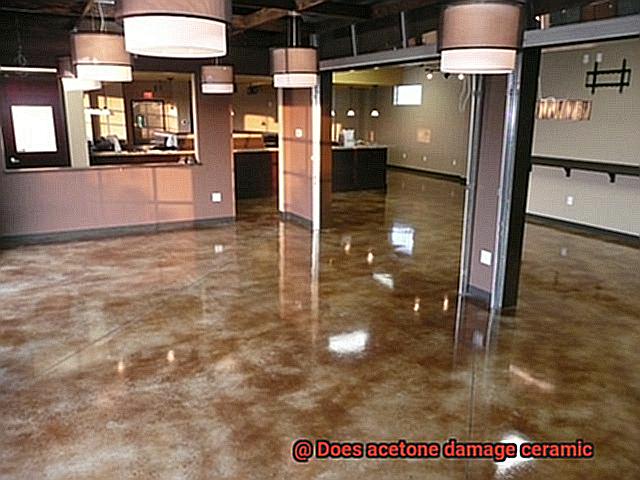
Acetone, a colorless and volatile liquid, possesses an unmistakable aroma. It belongs to the family of organic compounds called ketones and is composed of carbon, hydrogen, and oxygen atoms. This remarkable solvent showcases its prowess by dissolving plastics, paints, varnishes, and adhesives with ease.
How Does Acetone Interact with Ceramic?
- Resistance of Ceramic: While ceramic is generally impervious to most chemicals due to its non-porous nature, it’s important to note that different types of ceramics exhibit varying levels of chemical resistance. Porcelain, with its exceptional strength, often outshines earthenware or stoneware when it comes to facing off against chemical agents.
- Effects on Glazes and Finishes: When exposed for extended periods, acetone may leave behind its mark on certain ceramic glazes or finishes. Discoloration or a loss of luster can occur, especially if the glaze is weak or damaged. It’s essential to take precautions to preserve the beauty and integrity of ceramic surfaces.
Precautions and Recommendations:
- Patch Test: Before delving into full-scale acetone application, it’s advisable to perform a patch test on an inconspicuous area of the ceramic surface. This test helps gauge compatibility and assess potential damage before proceeding further.
- Prompt Cleaning: To minimize any risk of damage, it is crucial to clean acetone off ceramic surfaces promptly after use. Thoroughly rinse the area with water to eliminate any residual acetone and prevent prolonged exposure that could lead to undesirable effects.
- Safety Measures: Remember, acetone is highly flammable and can be harmful if ingested or inhaled. Ensure proper ventilation, wear protective gloves, and exercise caution when handling acetone to ensure a safe experience.
What is Ceramic?
Prepare to embark on a journey through time and witness the enchanting transformation of clay into a formidable substance that has shaped civilizations, adorned homes, and revolutionized industries.
Let us begin by unraveling the essence of ceramic. Derived from the Greek word “keramos,” meaning pottery or earthenware, ceramic is a material that has been cherished by humans for thousands of years. It all starts with humble clay, mixed with other natural materials, and then subjected to intense heat. This process gives birth to a solid and unyielding material capable of withstanding the ravages of time.
Versatility is the hallmark of ceramic. Throughout history, it has served as vessels for storing sustenance and quenching thirst, laid the foundation for majestic structures, and been transformed into decorative objects that breathe life into our living spaces.
But what truly sets ceramic apart is its unwavering resilience in the face of scorching temperatures. Whether it’s a culinary adventure in the kitchen or an industrial environment like kilns and furnaces, ceramic fearlessly withstands the heat. Not only that, it is resistant to wear and corrosion, making it a reliable choice for diverse settings.
Delve deeper into this captivating material, and you’ll discover an array of ceramic types, each with its own unique qualities and applications. Behold porcelain, renowned for its ethereal beauty and delicate translucency, adorning fine china and captivating decorative items. Meanwhile, stoneware takes center stage in our kitchens as our trusty dinnerware and kitchenware.
But there’s more to ceramic than meets the eye. Its exceptional thermal retention abilities make it an ideal companion for keeping your coffee piping hot in the morning. In fact, it plays a crucial role in insulation materials and heating elements, contributing to our comfort and warmth. And did you know that ceramics can be engineered to possess specific electrical properties? Yes, they power up electronic components like capacitors and resistors, igniting our technological advancements.
Fast forward to contemporary times, and ceramic has seamlessly woven itself into the realms of medicine and dentistry. Its biocompatibility makes it a safe choice for implants, prosthetics, and dental restorations. So, the next time you flash that dazzling smile, remember to thank ceramic for its contribution.
With its strength, heat resistance, durability, and aesthetic appeal, ceramic has become an indispensable material across various industries. However, we must also ensure its longevity and beauty. Stay tuned as we explore the potential impact of acetone on ceramic surfaces and uncover the best practices for preserving this timeless material.
Does Acetone Damage Ceramic?
Ceramic, a timeless material that brings beauty to our daily lives, may sometimes meet its match in acetone. This powerful solvent, renowned for its ability to dissolve stubborn substances like glue and paint, raises the question: Can acetone and ceramic coexist harmoniously? Join us as we delve into the intricate dance between acetone and ceramic to reveal the truth.
When it comes to acetone and ceramic, harmony can be achieved if certain precautions are taken. However, it’s essential to consider various factors such as the type of ceramic, concentration of acetone, and duration of exposure. Not all ceramics are created equal—porcelain, with its robust nature, tends to be less vulnerable to acetone’s potential damage than other ceramics.
Testing the Waters:
Before subjecting your beloved ceramic treasures to the power of acetone, a small test on an inconspicuous area is a wise move. This simple yet crucial step can save you from heart-wrenching disasters like discoloration or etching caused by an unfavorable reaction between acetone and specific ceramic glazes or finishes. Better safe than sorry.
Handle with Care:
When treating ceramic surfaces with acetone, caution should be your guiding principle. Opt for a gentle approach by applying a small amount of acetone onto a cloth or cotton swab before delicately wiping the affected area. Avoid direct pouring or spraying, as these actions can heighten the risk of damage.
The Aftermath:
After successfully banishing glue residues or other unwanted substances using acetone, don’t forget to lavish your ceramic surface with a thorough rinse of water. This final step ensures the complete removal of any residual acetone and guards against potential long-term damage. Your exquisite ceramics deserve nothing less than tender loving care.
When in Doubt, Seek Guidance:
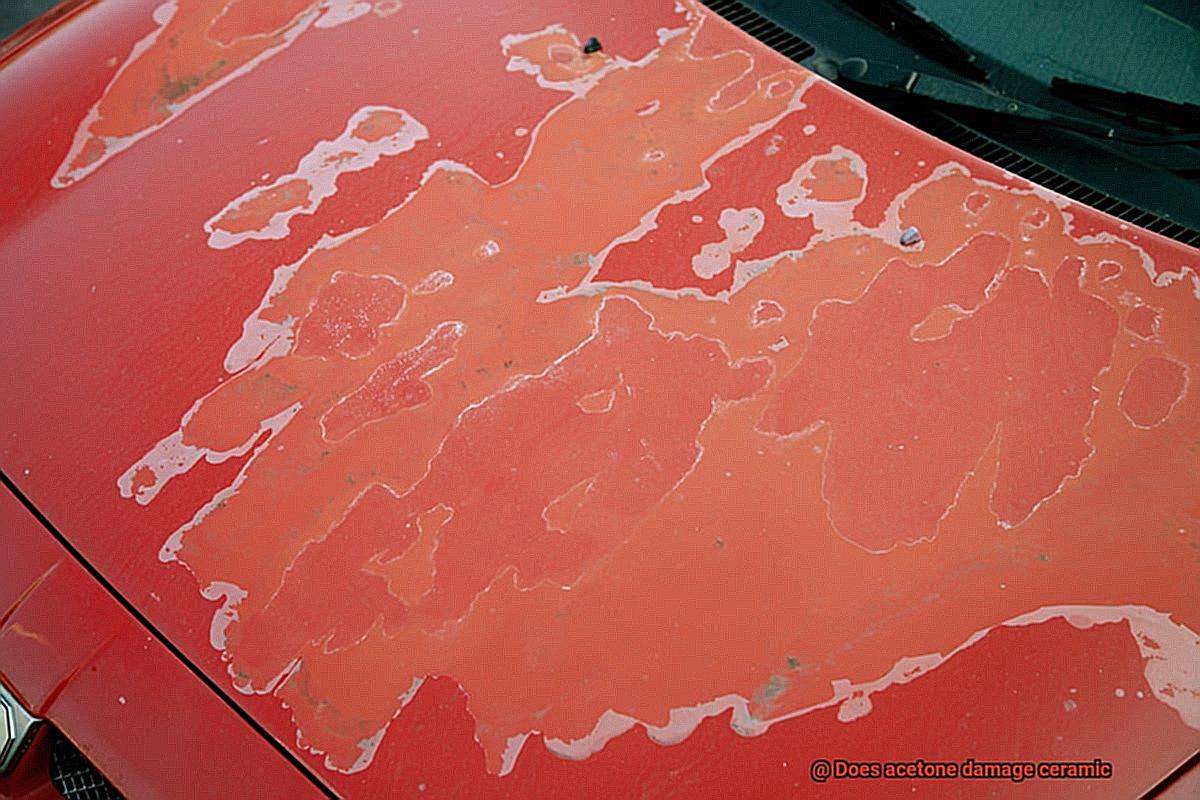
If uncertainty lingers regarding the compatibility of acetone with a particular ceramic item, especially if it boasts unique finishes or decorations, it’s best to seek professional advice. Consult with a ceramic expert or the item’s manufacturer to ensure you’re making the most informed decisions for your cherished pieces.
Factors Affecting Damage to Ceramic from Acetone
Ceramic materials possess intricate designs and beautiful finishes that make them highly prized possessions. However, when it comes to cleaning or repairing ceramics, caution must be exercised to avoid damaging these delicate objects. Acetone, a potent solvent commonly used for adhesive removal and general cleaning purposes, can potentially harm ceramics if not used properly. This article delves into the factors that affect the extent of damage caused by acetone to ceramic materials, empowering you to safeguard your cherished ceramic treasures.
Ceramic Composition:
The composition of ceramic material is critical in determining its resistance to acetone. Some ceramics, due to their porous structure, are more susceptible to damage, while others with denser structures offer greater resistance.
Surface Finish:
The surface finish of ceramics also impacts their vulnerability to acetone damage. A glossy or glazed surface acts as a protective barrier against the solvent, while a rough or matte surface allows easier penetration of acetone.
Duration of Exposure:
The length of time ceramics are exposed to acetone influences the degree of damage. Short-term exposure may have minimal impact, but prolonged exposure can lead to significant deterioration.
Concentration of Acetone:
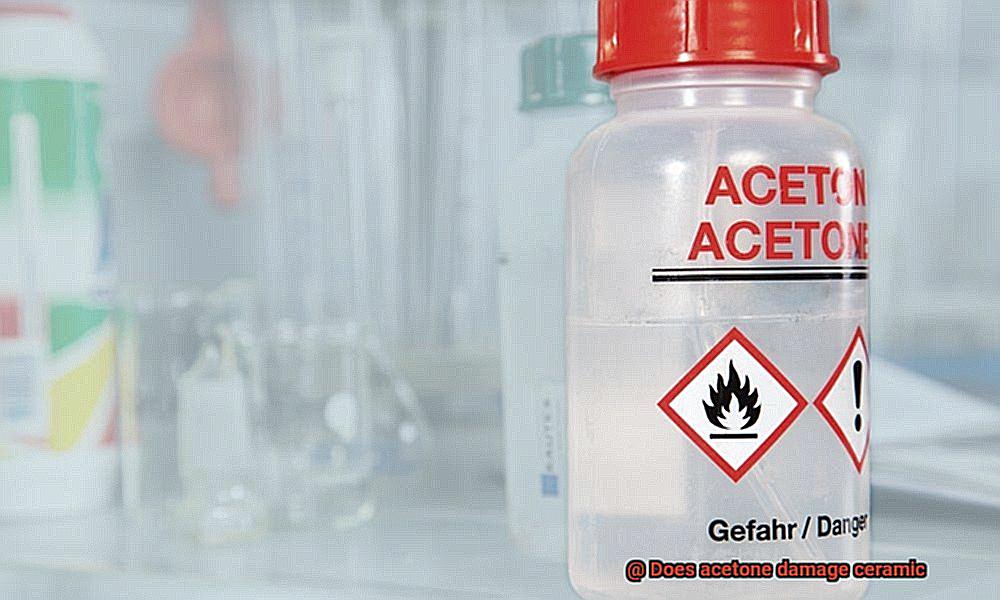
The concentration of acetone used determines the level of damage inflicted. Higher concentrations are generally more corrosive and cause faster and more severe damage to ceramics.
Temperature:
The temperature at which acetone is applied affects its interaction with ceramic surfaces. Extreme temperatures, whether hot or cold, intensify the damaging effects of acetone on ceramics.
Chemical Stability:
The chemical stability of ceramic materials is an important consideration. Some ceramics are chemically stable and resistant to solvents like acetone, while others are more reactive and prone to degradation when exposed to it.
Prior Treatment or Coating:
Ceramics that have undergone prior treatments or coatings, such as glazes or protective sealants, exhibit greater resistance to acetone damage. These additional layers act as a barrier between the solvent and the ceramic surface, reducing the potential for harm.
Mechanical Stress:
External factors like mechanical stress or friction contribute to acetone damage on ceramics. Scratching or scraping the surface of a ceramic object while cleaning it with acetone accelerates the deterioration process.
Repeated Exposure:
Even short durations of repeated exposure to acetone have cumulative effects on ceramic materials. Frequent contact with acetone gradually weakens the ceramic structure over time.
Potential Effects of Acetone on Ceramic Surfaces
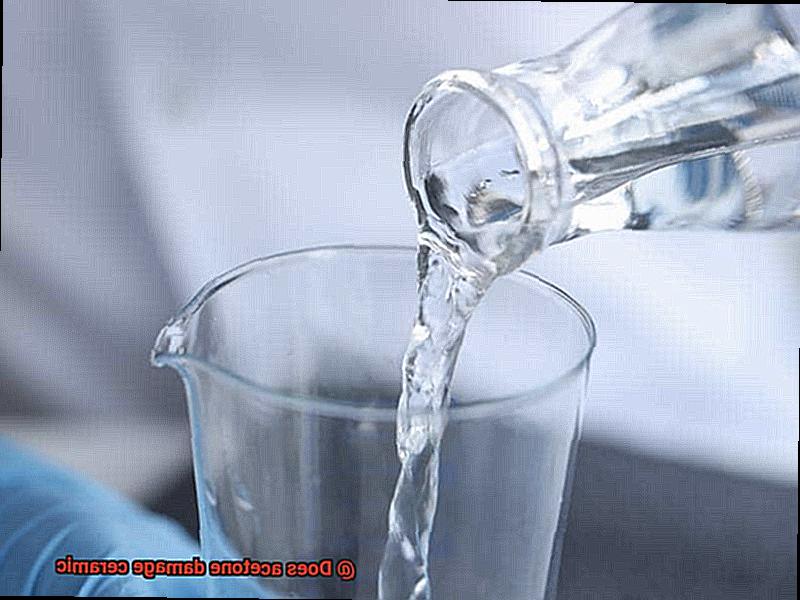
Ceramics, those delicate and beautiful pieces that we all cherish, require special care to maintain their pristine appearance. Today, we delve into the fascinating world of acetone and its potential effects on ceramic surfaces. Acetone, a powerful solvent renowned for its adhesive-dissolving abilities, can pose risks when coming into contact with ceramics.
Firstly, let’s talk about discoloration. The potent solvent properties of acetone can strip away the protective glaze or finish on ceramics, resulting in a transformation of color and appearance. Glazed ceramics are particularly susceptible to this phenomenon as acetone infiltrates the glaze, interacting with the material beneath.
But wait, there’s more. Etching, a captivating yet visually unappealing effect, is another potential consequence of acetone on ceramics. This mighty solvent has the power to dismantle the molecular structure of certain materials. When applied to ceramic surfaces, it can create minuscule pits and indentations, leaving behind an unsightly aftermath and compromising the surface’s smoothness.
And let us not forget about the adhesives. Many ceramics rely on adhesives or glues to maintain their structural integrity. Alas, acetone can be a cruel enemy to these bonds. With its forceful nature, it weakens or dissolves the adhesives, jeopardizing the stability of the ceramic piece itself.
To minimize harm when using acetone on ceramic surfaces, it is advisable to conduct a spot test in an inconspicuous area before applying it all over. This preliminary examination allows you to witness any adverse reactions and tweak your approach accordingly.

Should you find yourself in need of removing adhesive from a ceramic surface, use acetone sparingly and with caution. Gently dabbing a small amount of acetone on a clean cloth and applying it to the affected area can help mitigate the risk of discoloration, etching, or damage to adhesives.
Now, let us explore alternatives. There are methods of glue removal from ceramic surfaces that do not involve the use of acetone. Heat, mechanical scraping, and specialized adhesive removers formulated specifically for ceramics present less risk of damage to the surface.
How to Use Acetone on Ceramic Safely
Well, fear not. Today, we’re diving into the world of acetone and how to use it safely on ceramic surfaces. Acetone is like a superhero when it comes to removing adhesives, paints, and stains from ceramics, but it’s important to handle it with care to avoid any unintended consequences. So, let’s explore the steps to safely use acetone on ceramic surfaces.
Test a small spot first:
Before diving headfirst into using acetone, always test it on a small, hidden area of your ceramic surface. This will help ensure that the acetone does not cause any damage or discoloration. Apply a small amount of acetone on a cotton swab or cloth and gently rub it on the tested area. Observe for any adverse reactions such as discoloration, etching, or surface damage. If everything looks good, proceed with confidence.
Ventilate the area and gear up:
Just like a superhero preparing for action, you need to ventilate the area well before using acetone. Open windows or doors to ensure proper air circulation and avoid inhaling the fumes. Additionally, wear gloves made of nitrile or latex and safety goggles to protect your skin and eyes from potential irritation or burns.
Apply acetone with care:
Using a clean cloth or cotton swab soaked in acetone, gently dab and rub the affected area on the ceramic surface. Avoid applying excessive pressure or scrubbing vigorously, as this can cause scratches or damage. For larger areas or stubborn stains, use a soft-bristled brush or sponge soaked in acetone to carefully remove the adhesive or stain.
Rinse thoroughly and dry:
After successfully removing the adhesive or stain, rinse the ceramic surface thoroughly with water. This step is crucial to remove any residual acetone. Make sure to rinse multiple times to ensure all traces of acetone are gone. Once rinsed, dry the ceramic surface completely using a clean, lint-free cloth. This will prevent any water spots or streaks from forming.
Repeat if necessary:
If there are still traces of adhesive or stain remaining, you can repeat the process of using acetone until the desired result is achieved. However, proceed with caution and closely monitor the ceramic surface for any signs of damage or discoloration. If you notice any adverse reactions, stop using acetone and consider alternative methods.
Possible Restoration Solutions for Damaged Ceramics
Ceramics hold a special place in our hearts, evoking memories and capturing our imagination with their beauty. Yet, accidents can occur, leaving these treasures damaged. Fear not. There are a plethora of restoration solutions available to revive these broken ceramics. This article will delve into the power of adhesive options and other techniques to restore damaged ceramics.
Adhesive Solutions:
Epoxy Glue:
Renowned for its robust bonding properties, epoxy glue is a popular choice for repairing broken ceramics. This adhesive consists of two components that must be mixed before application. Once applied, epoxy glue forms a durable bond capable of withstanding normal wear and tear. However, caution is advised as epoxy glue may create a visible line at the repair site, which can be noticeable on delicate or ornate ceramics.
Cyanoacrylate Glue:
Also known as super glue, cyanoacrylate glue offers an instant bond when applied to clean and dry surfaces. Particularly effective for small, precise repairs like reattaching chips or fragments, this adhesive should be utilized cautiously for larger or complex repairs due to potential brittleness over time.
Silicone Adhesive:
For outdoor ceramic restorations such as garden ornaments or tiled surfaces, silicone adhesive is an ideal choice. Its flexibility and durability make it resistant to moisture, temperature changes, and UV radiation. However, its visible appearance and limited color options may render it less suitable for decorative ceramics.
Ceramic-specific Adhesives:
Tailored specifically for ceramic repairs, ceramic cement or ceramic epoxy adhesives provide seamless bonding without compromising the ceramic’s appearance or structural integrity. With various color options available, these adhesives are perfect for intricate patterns or designs.
Other Restoration Techniques:
- Re-glazing: Applying a new layer of glaze can restore the appearance and functionality of a damaged ceramic piece. However, re-glazing may not always be feasible or suitable for all types of damage.
- Filling and Painting: Minor cracks or chips can be repaired by filling the damaged area with a filler material and subsequently painting it to match the original color and pattern.
- Molding and Casting: In cases of significant damage or loss, professionals may employ this technique, creating a mold of the original piece and casting a replica using materials like plaster or resin. While this method can result in a restored ceramic piece, it may not fully retain the original’s characteristics.
Safety Precautions When Using Acetone
Acetone, a powerful chemical commonly used in ceramic restoration and DIY projects, requires strict safety precautions to protect yourself and others. To ensure a safe environment for using acetone, follow these guidelines:
- Adequate Ventilation: Acetone is highly flammable and can release pungent fumes. Always work in a well-ventilated area or use fans to maintain proper airflow. This prevents the inhalation of harmful vapors that can cause respiratory issues.
- Personal Protective Equipment (PPE): Prioritize personal safety by wearing protective gloves and goggles. Acetone can irritate the skin and cause eye damage upon contact. Don’t underestimate the importance of these precautions – they’re not only practical but also fashionable.
- No Open Flames: Keep any open flames or lit cigarettes far away from acetone. Since it is highly flammable, even a tiny spark could ignite it, resulting in unwanted fires. Remember, it’s better to be safe than sorry.
- Proper Storage: Store acetone in a cool, dry place away from direct sunlight and heat sources. Ensure that the container is tightly sealed to prevent evaporation or leakage. A well-organized storage area minimizes the risk of chemical accidents.
- Avoid Mixing Chemicals: Never mix acetone with other chemicals unless directed by a professional. Combining acetone with certain substances can lead to hazardous reactions or the release of toxic gases. Leave the mixing to the experts.
- Responsible Disposal: Disposing of acetone incorrectly poses serious environmental risks. Do not pour it down the drain or throw it in the trash bin. Contact your local waste management facility for proper disposal methods to protect our environment.
- Accidental Ingestion: If you accidentally swallow acetone, seek immediate medical attention. Do not induce vomiting without professional guidance. It’s crucial to let healthcare professionals handle such situations.
- Skin Contact: In case of skin contact, wash the affected area with soap and water for at least 15 minutes. If irritation persists, seek medical assistance promptly. Prompt action can prevent further complications.
- Eye Contact: If acetone gets into your eyes, rinse them gently with water for at least 15 minutes. Then, without delay, seek immediate medical help. Quick response is vital to protect your eyesight.

